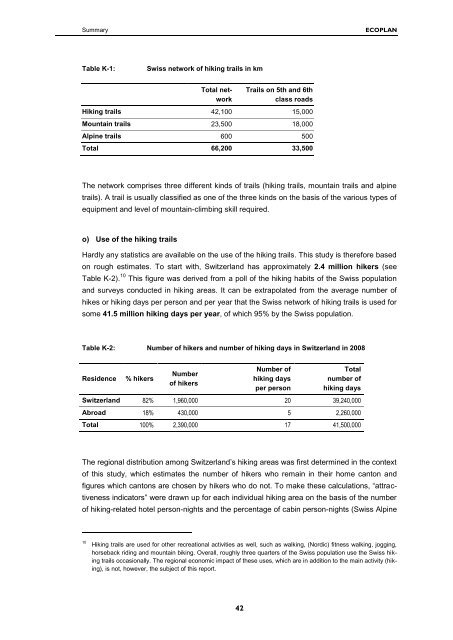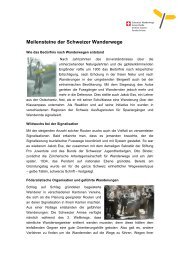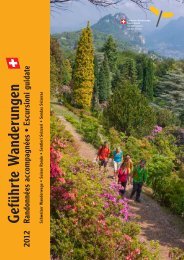Ökonomische Grundlagen der Wanderwege in der Schweiz
Ökonomische Grundlagen der Wanderwege in der Schweiz
Ökonomische Grundlagen der Wanderwege in der Schweiz
Sie wollen auch ein ePaper? Erhöhen Sie die Reichweite Ihrer Titel.
YUMPU macht aus Druck-PDFs automatisch weboptimierte ePaper, die Google liebt.
Summary ECOPLAN<br />
Table K-1: Swiss network of hik<strong>in</strong>g trails <strong>in</strong> km<br />
Total network<br />
42<br />
Trails on 5th and 6th<br />
class roads<br />
Hik<strong>in</strong>g trails 42,100 15,000<br />
Mounta<strong>in</strong> trails 23,500 18,000<br />
Alp<strong>in</strong>e trails 600 500<br />
Total 66,200 33,500<br />
The network comprises three different k<strong>in</strong>ds of trails (hik<strong>in</strong>g trails, mounta<strong>in</strong> trails and alp<strong>in</strong>e<br />
trails). A trail is usually classified as one of the three k<strong>in</strong>ds on the basis of the various types of<br />
equipment and level of mounta<strong>in</strong>-climb<strong>in</strong>g skill required.<br />
o) Use of the hik<strong>in</strong>g trails<br />
Hardly any statistics are available on the use of the hik<strong>in</strong>g trails. This study is therefore based<br />
on rough estimates. To start with, Switzerland has approximately 2.4 million hikers (see<br />
Table K-2). 10 This figure was <strong>der</strong>ived from a poll of the hik<strong>in</strong>g habits of the Swiss population<br />
and surveys conducted <strong>in</strong> hik<strong>in</strong>g areas. It can be extrapolated from the average number of<br />
hikes or hik<strong>in</strong>g days per person and per year that the Swiss network of hik<strong>in</strong>g trails is used for<br />
some 41.5 million hik<strong>in</strong>g days per year, of which 95% by the Swiss population.<br />
Table K-2: Number of hikers and number of hik<strong>in</strong>g days <strong>in</strong> Switzerland <strong>in</strong> 2008<br />
Residence % hikers<br />
Number<br />
of hikers<br />
Number of<br />
hik<strong>in</strong>g days<br />
per person<br />
Total<br />
number of<br />
hik<strong>in</strong>g days<br />
Switzerland 82% 1,960,000 20 39,240,000<br />
Abroad 18% 430,000 5 2,260,000<br />
Total 100% 2,390,000 17 41,500,000<br />
The regional distribution among Switzerland‟s hik<strong>in</strong>g areas was first determ<strong>in</strong>ed <strong>in</strong> the context<br />
of this study, which estimates the number of hikers who rema<strong>in</strong> <strong>in</strong> their home canton and<br />
figures which cantons are chosen by hikers who do not. To make these calculations, “attrac-<br />
tiveness <strong>in</strong>dicators” were drawn up for each <strong>in</strong>dividual hik<strong>in</strong>g area on the basis of the number<br />
of hik<strong>in</strong>g-related hotel person-nights and the percentage of cab<strong>in</strong> person-nights (Swiss Alp<strong>in</strong>e<br />
10 Hik<strong>in</strong>g trails are used for other recreational activities as well, such as walk<strong>in</strong>g, (Nordic) fitness walk<strong>in</strong>g, jogg<strong>in</strong>g,<br />
horseback rid<strong>in</strong>g and mounta<strong>in</strong> bik<strong>in</strong>g. Overall, roughly three quarters of the Swiss population use the Swiss hik<strong>in</strong>g<br />
trails occasionally. The regional economic impact of these uses, which are <strong>in</strong> addition to the ma<strong>in</strong> activity (hik<strong>in</strong>g),<br />
is not, however, the subject of this report.






